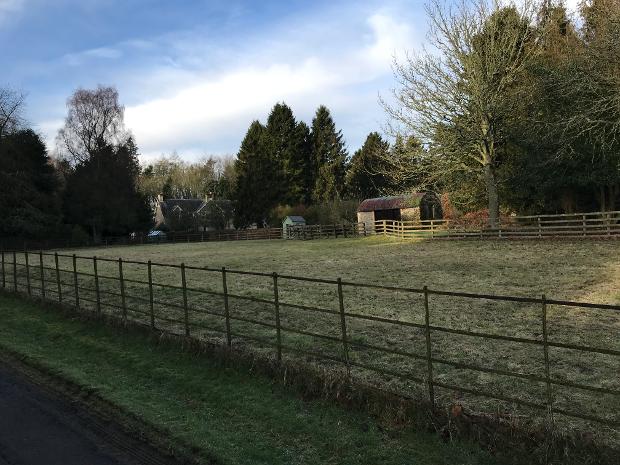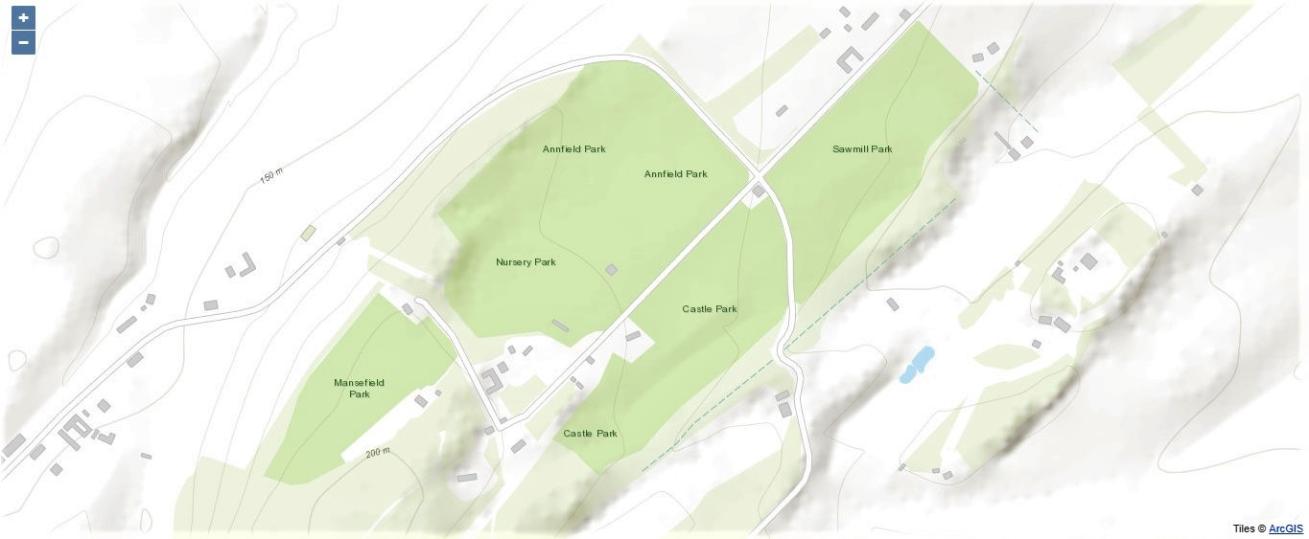
CAVERS - THE LOST BORDERS TOWN - PART ONE
BY ALASTAIR M REDPATH
Just three miles south-east of Hawick lies the wee hamlet of Cavers, a place that gives few clues away as to its former size and importance. Although first appearing as ‘Kaveres’ in the early 13th century, its origins go much deeper through time, to temporary Roman camps at Cavers Mains and nearby Eastcote, and a cluster of Iron Age hill forts and hut-circles scattered around Ruberslaw.
Few buildings, if any, in the Hawick area predate the Battle of Flodden. One that can claim to is the lower portion of Cavers House, now a ruin, previously discussed in greater detail in this column (July 14, 2017). The story of the lost Borders town of Cavers is inextricably linked with the rise of Cavers House and its neighbour, Cavers Auld Kirk, which is described as the mother church of a chapel of ease established on banks of the ‘Slitrith’ following St. Cuthbert’s death in 687. Two worshippers from ‘Hawic’, Saegifa and Rosfritha, reportedly witnessed a candle going out on the altar, only to be miraculously replaced by another, brighter flame. These two women hold the distinction of being the first Teries named in any written records. This ancient chapel is believed to have been sited at Cogsmill, near Adderstoneshiels Farm. A ring of trees was planted in 1830 to mark its possible location. Reginald, who wrote of the miracles around the middle of the 12th century, apparently obtained his information from a parson of the church of Cavers.
Stretching in early times from the lower River Rule to the southernmost reaches of Teviotdale, the parish of Cavers anciently contained a church at Kirkton and chapel of ease at Carlenrig (until Teviothead parish was formed in 1850). The parish was subdivided as ‘Parva’ or ‘Petyt’ Cavers and ‘Magna’ Cavers i.e. Little and Great Cavers, during the time of Lovel family’s influence over Hawick. The benefice of Little Cavers is mentioned in the Bagimonds Roll of 1275-79 and its chapel swore fealty to Edward I at Berwick in 1296.
The settlement at Little Cavers was no more than a hamlet, lying midway between Cavers Mains and Honeyburn. It became a parish in its own right during the 16th century and took the name ‘kirk toun’ i.e. Kirkton, to distinguish it from the ‘ferm toun’ at Cavers. Links between the two subdivisions go back a long way; from 1335 to 1367 we see a Kirkton man, William de Tofts, installed as parson of Cavers.
It is clear then that Cavers has had a church - in some shape or form - for the better part of 1,300 years. What is less clear, however, is how the Baliol family were installed as barons of Cavers, and when they built the first tower on the site of Cavers House; John Baliol, King of Scotland from 1292-1296, was nephew to the Lord of Cavers. Robert the Bruce later rewarded ‘The Good’ Sir James Douglas, a trusted lieutenant at Bannockburn in 1314, with lands spread across Scotland (for more on him, see the February 17, 2017 edition). These included Cavers, granted by the ‘Emerald Charter’ and elevated to a regality. All church lands and possessions on the Cavers estate were granted to the monks of Melrose around 1358 by William, Earl of Douglas - confirmed by the Pope in 1394, but only taking effect by 1419! The titles of the monks were again examined and ratified by James I in 1482.
When Sir Archibald Douglas succeeded to the barony of Cavers in 1382, he granted the lower portion, which included Denholm and Spittal (where a hospital once stood for pilgrims, the diseased, and poor, with the Black Douglases as its patrons), to Thomas Cranstoun, in recognition of good and faithful service, for an annual payment of one silver penny. The Dominical (church) lands of Denholm referred to in the chapters during the time of the Cranstouns were probably at Honeytown by the Stonyburn, known today as Honeyburn. The house at Honeyburn still has a cross on its north-west gable. A possible explanation for the naming of the Canongate in Denholm is that the monks used to come that way into the village on their way to church properties on Cavers land. They are said to have had an apiary at Honeyburn where they came to collect their honey.
It is likely that the town of Cavers began to develop around the new regality and church lands in the decades following the Wars of Independence, on marshy ground that is still surrounded today by a number of small lochs and ponds. It stretched from the houses which now surround the Auld Kirk, to Cavers Townfoot at its junction with Cavers Parish Church. The remains of the town’s medieval market cross are fenced off at the south end of the main avenue, the Townhead, of which only the socket and fragments of the shaft now exist. It was once the centrepiece to and beating heart of a bustling market square. The public well is now covered up in an adjacent garden.
The densest population was at Townhead, and it is still possible to see the outlines of old houses in the field alongside the avenue that leads to the Parish Church; the last of these, a low mortar-less structure, was still visible until the 1930s. Though its population was small by today’s standards, the town is said to have no fewer than nine inns or public houses!
Through Acts of the Scottish Parliament we learn that Cavers was burnt by an English force under Lord Dacre, in league with Sir Walter Scott of Branxholme, in 1535. It was again burned in October 1541, and “brent, rased and cast downe” by the Earl of Hertford in 1545. According to the National Statistical Account, the town of Cavers was laid to waste in 1596.
In 1658, Sir Archibald Douglas purchased back the lands at Denholm and Spittal, added to them, and built Westgate Hall in 1664 – which still stands today. The united arms of Sir Archibald and his wife, Dame Rachel Skene (daughter of the President of the College of Justice), are carved into the bas-relief above the fireplace in the kitchen. The estate of Cavers gradually stretched to some 10,000 acres.
The new Laird and his family were fervent Covenanters. In 1662 the Douglases refused to admit a curate sent by the official Church, and representatives from Jedburgh were stoned by the women of Cavers. After this the Covenanters in the area were persecuted by law and had to resort to secret conventicles and prayer meetings in hidden places such as Peden’s Pulpit on Ruberslaw and Peden’s Vale at Denholm Dean (just below the ruined cottage). In 1690 the Presbyterians were finally recognised as the established Church in Scotland but the strictest Covenanters would not join it. A group of them known as the Cameronians formed their own congregation in Denholm, under the patronage of the Douglas family at Cavers.
The population of the town of Cavers looks to have peaked around the beginning of the Agrarian Revolution in c.1674. A major blow came when the Laird feued 8.5 acres at the ‘Auld Yairds’ in Denholm, allowing new buildings to be erected there. Another great loss was the market’s shift to Denholm, where two half-yearly were appointed by order of William III in 1696, on June 16 and November 5, for a period of eight days annually. Sheriff Officers from Jedburgh were summoned to maintain order. By the end of the decade, there were just twelve residents left in the auld town.
Denholm Green became the new centre of commerce for the parish of Cavers. The two fairs were used for just about everything, from hiring labourers and selling sheep or cattle, to buying salted butcher meat to last through the winter months. The Laird of Cavers would proclaim the opening of each fair from the new Denholm Cross (which stood on the site of the Leyden Monument until turn of 19th century). Before each opening night, a bonfire was held on the Green. At the Summer fair, games were held to entertain the masses.
Though the population of Cavers town continued to drop steeply at a time when the nation was becoming more urbanised, the population of the parish rose steadily; In 1755, 993 people lived in Cavers parish (compared with 330 at Kirkton and 2,713 in Hawick). By 1861, that figure nearly doubled to 1,824. Despite the rapid decline of Cavers town, the parish survived, as we’ll find out next week.
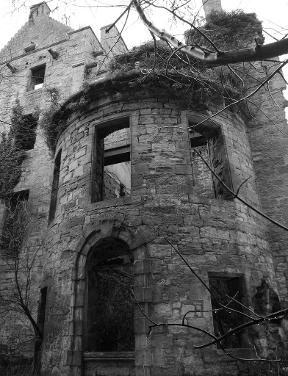
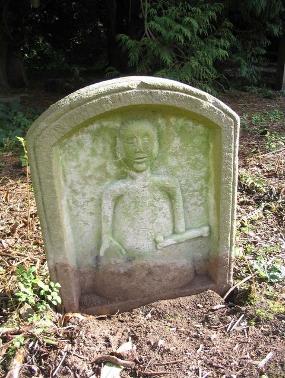
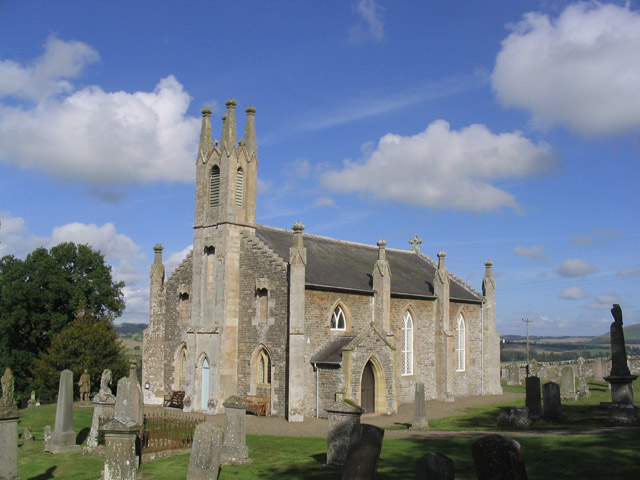

Image Credits, from left to right :
The Bow windows on the east elevation of Cavers House. James TM Towell. Used under creative Commons License SA 2.0
Grave Marker in Cavers Auld Kirkyard. Walter Baxter. Used under creative Commons License SA 2.0
Cavers Church. Walter Baxter. Used under creative CommonsLicense SA 2.0
The south elevation of Cavers House. James TM Towell. Used under creative Commons License SA 2.0
CAVERS - THE LOST BORDERS TOWN - PART two
BY ALASTAIR M REDPATH
Cavers enjoyed a brief revival during the mid-18th century as employment grew around the 10,000 plus acre estate. In 1754-55 its various farms were let to seventeen tenants at £20 per annum, though some chose to pay their dues in ‘bear’ (barley), ‘meal’ (oatmeal) and ‘boll’ (a dry measure of grain). In addition there were four corn mills on the estate at Cauld Mill, Trow Mill, Denholm Mill and Spittal Mill, mainly used as a food supply for pigs and poultry.
The largest farms were required to send dozens of different birds each month to the ‘big hoose’ i.e. Cavers House, which was also a major employer in the area, with no less than nineteen servants - as well as cooks, chambermaids, kitchen maids, housekeepers, footmen and gardeners. Lady Cavers’ monthly disbursements paid for services which sustained many Hawick traders through the year, covering all manner of businesses from accoutrement makers to wrights. As many as 292 carriages of coal were brought from the seams of Northumberland to meet the estate’s yearly demands. The grounds to the south of the house were also used to hunt deer and birds.
There was lint spinning at Cavers West Mains, clay pits at Cavers Knowes, and as many as 200 men found work in the local quarries when a big job was at hand. The last of the stone from Denholm Hill quarry, for instance, was used in the reconstruction of Cavers House in 1750.
The estate part-funded a series of new roads and fully paved others to deal with the influx of traffic. Between 1765 and 1766, a team of roadbuilders under Laurence Porteous of Hawick paved surfaces from Cavers Entry to the Auld Kirk, onto Cavers Manse, and from Braehead to Hawick. The Turnpike Act of 1768 was hastened by the need to transport industrial fuel, and these new roads were used to carry coal, animals and goods to market, and all sorts of building materials. In that year the estate paid a further £10 to create a new route from Mosspaulgreen to Haremoss. Two years later, a team of day labourers under James Simpson of Hawick planted trees all the way from Trowmill to Cavers, supplied by the plentiful stocks at nearby Dickson’s Nurseries.
Though the rural congregation of the parish increased over the century, the population of the greatly diminished town of Cavers (now a village) fell. A decision was made to move the school from Cavers Townhead to Little Cavers (Kirkton), then Denholm Green in c.1802 - although it did return to the Auld Kirk in 1842. At Cavers Cottages a girls’ school existed for a few years in the 1860s. Denholm was a much more attractive prospect – people left to take up new feu options around the Green, supported by the relatively new stocking frame industry. By 1844 there were eighty-seven stocking frames in Denholm. Cavers village failed to recover and has long since been a peaceful country hamlet.
Last week we covered the history of Cavers Auld Kirk up to the early 16th century. The church was originally in the shape of a crucifix – comprising three burial aisles - with the northern transept being the Elliott Aisle for the Elliotts of Stobs, and the southern one - ‘the Porch’ - being the Gledstains Aisle for the Gladstones of Cocklaw, built in 1524.
The altar at the east end was converted into the Douglas Aisle for the Douglases of Cavers, with Laird’s Loft above added in the mid-17th century. The loft was once reached by an outside staircase, from which the theologian Thomas Boston once preached. That doorway is now built up. The lowest portions of the east gable, north wall and north-west corner are from the original building, demolished and rebuilt in 1662. A long slit in the northern end is called the ‘leper’s squint’ and would have allowed poorer parishioners to watch sermons in pre-Reformation times.
The door in the west gable was likely the main entry into the church. It is crowned with an open belfry which had a new bell installed in 1669, possibly from Hassendean Church. More building work took place at the north aisle, probably in 1730, as a window to the west entrance has ‘1730 M H K’ (Minister Hugh Kennedy) on the lintel into what is now the kitchen.
The Gledstains Aisle was unceremoniously pulled down by heritors during the 1745 Jacobite uprising for that family’s role in the rebellion. At that time, the Government – alarmed by the army raised by Highland chiefs and barons - abolished hereditary titles and heritable jurisdiction, greatly diminishing the power of the Douglas family in the process.
A stone memorial tablet built into the north wall of the Auld Kirk once marked the tomb of the infant son of the Reverend Hugh Kennedy who died in 1757, although no evidence remains. One of the kirk’s most famous appointments was Dr. Thomas Chalmers, a distinguished theological writer of his time, who was assistant to Thomas Elliot at Cavers in 1801-02. During part of that time he stayed in the Roberton Manse with his old friend Reverend Shaw, and later lodged in Kedie’s Gable, Hawick. Locally, Reverend Samuel Charters of Wilton was one of his mentors.
During the early 19th century each end of the kirk was occupied by a gallery with no space for seats underneath; beneath the west gallery was a rude vestry, beneath the east gallery was a space for gravedigger’s tools and other stores, lit by a narrow slit. The main access had switched to two doors on the south side, and between the windows was the pulpit. On the south wall stood three old-fashioned square pews, with more modern rows of seating sited adjacent to the pulpit. The twenty-nine Denholm victims of cholera in 1829 were buried in the north-west corner of the graveyard, though this part is no longer within its boundaries.
Denholm’s John Leyden, a renowned poet, linguist, minister, surgeon, naturalist, and great inspiration to Sir Walter Scott, spent part of his youth at Cavers. His father moved to Cavers Townhead in 1866 to the building which later became a mill wright’s shop. Leyden used to play pranks on people in the Auld Kirk, once persuading a neighbour to put his foot through the gravedigger’s slit, only to have a pal pull it through! On another occasion he convinced another resident that he could evoke spirits and speak in tongues – his pal jumped out from the gallery door (wearing the mort cloth) and the poor stooge ran off through the woods! There is a memorial in the graveyard to the last surviving Leyden brother, who was in the employment of Reverend Alex Davidson as late as 1866.
Following the opening of the new parish church in 1822, the east gallery and burial vault were cut off from the rest of the building by single rooms on the ground and first floors. The shortened church was used as a church hall, community space for plays, social gatherings and whist drives, and a school (from 1842 to 1939). The building was abandoned in the 1960s and was later used for agriculture storage before being converted into a home in 2005-08.
An uninscribed bell was said to be still in-situ in 1946, and the current owners purchased one from St Mary’s Church in Selkirk (demolished in 2004), erected at the north wall entrance rather than in the bell tower. The graveyard is well worth a look too. The table stone near the gate is said to be that of a Roman Catholic priest (dating to 1517), set so that his flock could be watched from the afterlife. Another table stone nearby has a date of 1649. One of the most interesting headstones is the long, rectangular ‘tree of life’, believed to be from 13th to 14th century, and one of only two of its kind in the UK (the other is in Yorkshire). The tree of life was believed to denote the link between the underworld, the living world and heaven, and appears as the source of eternal life in the Garden of Eden.
Further down the hill lies the Auld Kirk’s replacement, Cavers Parish Church. Built in 1822 with seats for 500 parishioners, its graceful square tower is styled with Byzantine ambitions. It had its interior remodelled in 1928 and at some point its entrance was changed to a different side and the ornamentation on the roof was lowered. An illuminated memorial scroll was added after the First World War, and the cemetery was extended in 1967. The manse is situated just to the west of the new church and was built in 1813.
In the churchyard there you’ll find the statue of William Leggat, a mentally handicapped “kenspeckle” parishioner of Cavers who was treated kindly by locals. Born in 1718 to Andrew Leggat, blacksmith at Cauldmill, and Elizabeth, Lady Cavers had a soft spot for William and regularly bought him clothes and shoes. He ran messages for the Douglas family, fetching vegetables for the cook and carrying bundles to and from the laundry. His likeness, complete with basket, was captured for Lady Cavers by a local mason from Denholm.
Willie didn’t take to it and aimed a kick at the dog at its base removing its left ear! Local legend states he was later stabbed to death by the cook for getting the wrong vegetables! Originally the statue stood in the walled garden but after a couple of hundred years of neglect it was left in pieces. After a spell in a Hawick garden, it was restored and placed in Cavers churchyard.
The Cavers estate remained in Douglas hands until 1975 when James Palmer-Douglas moved away and the remaining lands were put on the market. However, the family still retains small portions, including a burial plot in the corner of the Auld Kirk graveyard and a parcel of land surrounding the Hornshole monument. Though its town has long gone, its school has closed, its church has diminished in importance, and the estate on which it grew has all but disappeared, Cavers has survived. In the words of Leyden: “Green Cavers, hallow’d by the Douglas name, Tower from thy woods! Assert thy former fame!”
Reproduced with the kind permission of Alastair M Redpath.
Originally published in The Hawick Paper, 2018.
Credit: Hawick Archaeological Society Transactions (1911, 1913, 1938, 1946, 1999, 2012);
A Hawick Word Book (2017 ed.), Professor Douglas Scott; Companion to Hawick and District(4th ed.), R.E.Scott (2010)
Cavers Estate through the years
The Fencing on the Estate
Throughout the estate, there are many examples of what appear to be the 'original' estate gates, all built to the same design, again constructed of wrought iron, and all with matching gate posts.
This fencing is quite distinctive, and unique, certainly locally, to Cavers Estate.
What is particularly interesting is that this fencing is largely intact. Take a walk around many cities and towns, and you can't help but notice that much of the original wrought iron fencework has been removed, leaving, in many cases, stumps where the metal has been cut. This, of course, is a result of WW2, when the demand for iron was such that many wrought iron structures and fences were sacrificed for the war effort. The Cavers fences, however, survived.
It may have been that this was simply a case of them being too 'remote' to make procurement worthwhile, however it may also have been down to the politically influential Douglas family.
Might it be that the fences were spared as a favour to the Douglas family for their years of political service to the country ?
Or, and, let's face it, this is more likely, were the fences spared because removing them would mean that the estate would have no way of containing any livestock contained in the fields? Removing the wrought iron elements of the fence would mean removing ALL of the fence, unlike in towns and cities where removing the wrought iron railings left, for the most part, the lower parts of the walls onto which the railings were attached.
Whatever the reason, these fences, which look to be 19th century, remain, and are one of the estate's most distinguishing features.
The Douglas, tree, now sadly long gone, is the subject of what may only be a local legend, however with the the demise of the tree comes a peculiar point of note.
Standing approximately 100 metres NNE of Cavers House, at what was the entrance to the turning circle in front of the house, the Douglas Tree, which was, I think I recall, a chestnut tree, was an impressively large specimen of some considerable age.
The tree emerged from the ground, it seemed, as 3 separate entities. Three massive trunks reached up from a mossy forest floor springy with sphagnum moss and leaf litter, holding aloft a thick dark green canopy through which little light filtered. At a height of perhaps 20 feet or so, a number of heavy iron chains were evident. These chains had clearly, at some point in the past, been wrapped around the tree in what appeared to be an attempt to prevent one or all three of the limbs from falling. At the time that I discovered the tree, though, in the early 1990's, these chains were no longer wrapped around the tree, but had become consumed by it. Emerging from within each of the mighty limbs, the chains spanned from one giant limb to the next. Any slack that had been there when the chains were originally installed was long gone, and each span was now as tight as a piano string. Only their solid construction and the sheer scale of each of the chain links served to prevent the tree from succumbing to the winds.
I regret that I never took a photo of the tree when I first found it, as it wasn't long after that that the tree did eventually come down.
Intrigued by both the house and the tree, I conducted some research in the archives of the nearby Hawick library and discovered the story of the Douglas Tree.
Sadly, as I am writing this now nearly 30 years later, my memory of the finer details of the story is hazy, and so I may get some of what follows wrong. I welcome any corrections !
The story attached to the tree is as follows ...
Many years ago ... I am guessing, by the way the chains had been enveloped by the tree, the late 1800/early 1900's ... the then Laird of Cavers, Lord Palmer Douglas, unhappy at the service of one of the household staff, 'sacked' her.
Whether he knew what she was reported to be a witch or not is unclear, but what is clear, according to the legend, is that, enraged by what she felt was unfair treatment, she cursed the Palmer Douglas family.
She proclaimed that, should any one of the limbs of the tree fall, then the entire male Douglas family line would be wiped out, or otherwise brought to an end.
How this was to happen I don't recall, but that was the curse.
The Laird, terrified by the curse (and remember the supernatural was a much more potent force in those days), ordered that the tree be chained so that it could never fall. The chains used were of the strongest they could find, mighty iron links, with each link welded by a master welder to ensure the chain contained no weaknesses. Only once the chain was installed could the Laird relax, and the curse was all but forgotten.
Years went by, and the curse slipped from the minds of the family, a silly superstition from a bygone age.
Until early October of 1995.
That month, the UK was battered by the tail end of Hurricane Opal, and the Douglas Tree finally fell. Under the relentless assault from the southerly winds the chains snapped, and at least one of the limbs came down.
And there the story may have ended... except for one final curious twist of fate.
On 9th October, the ex prime minster of the UK, Lord Alec Douglas-Home, passed way at his home in the Hirsel, near Coldstream in the Scottish Borders.
He was the last surviving male member of the Douglas family, and passed away only a matter of days after the Douglas Oak came down.
So ... a legend, surely, as none of us believe in the power of witchcraft now, but a peculiar way for this story to end.
As I say, this is a recollection of a story I read many years ago, and I welcome any corrections. I do not claim that this story is true, however it is the story as I remember it. It's worth noting that there are many similar stories (The Alton Chained Tree, for example) and so, again, I stress, this is a local legend, and I cannot vouch for the veracity of the tale, but I can confirm that there WAS a chained tree, and i did see it before and after it fell !
Another version of the story, submitted by a local is ...
"The story was that the branches or tree wasn't allowed to touch the ground/earth. If the tree became of an age where it was going to do so, a joiner could make the tree into a small boat and, if it's kept floating on the pond to the rear of the house, the curse could not come to pass as the tree was still not in contact with the ground." Submitted by Gemma Lubbock.
© Copyright Cavers - The History/Simon Watson
